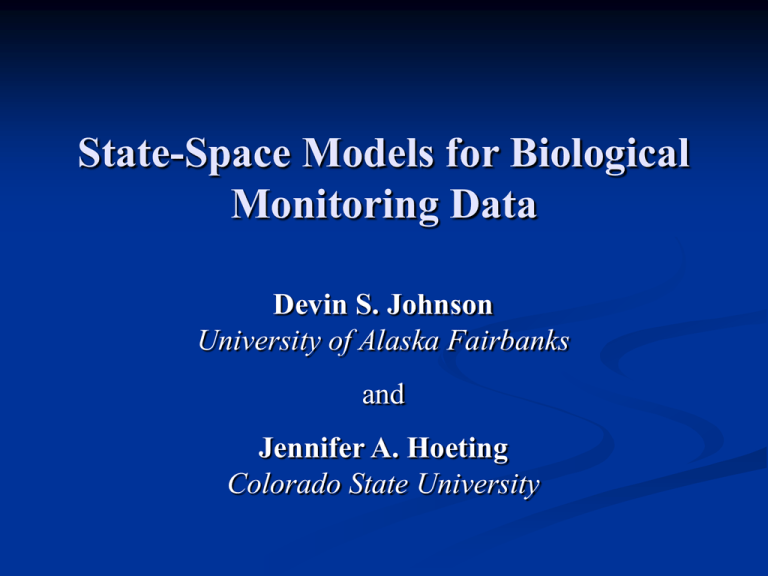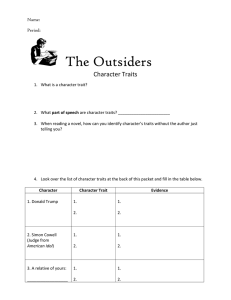State-Space Models for Biological Monitoring Data Devin S. Johnson Jennifer A. Hoeting
advertisement

State-Space Models for Biological
Monitoring Data
Devin S. Johnson
University of Alaska Fairbanks
and
Jennifer A. Hoeting
Colorado State University
The work reported here was developed under the STAR
Research Assistance Agreement CR-829095 awarded by the
U.S. Environmental Protection Agency (EPA) to Colorado State
University. This presentation has not been formally reviewed by
EPA. The views expressed here are solely those of presenter
and the STARMAP, the Program he represents. EPA does not
endorse any products or commercial services mentioned in this
presentation.
# CR - 829095
Outline
Biological monitoring data
Previous methods
Bayesian hierarchical models
previous models
Multiple trait models
Continuous trait models
Analysis of fish functional traits
Biological Monitoring Data
Organisms are sampled at several sites.
“Individuals” are classified according to a set F of
traits
Example:
Longevity
Trophic guild
1. 6 years
1. herbivore
2. > 6 years
2. omivore
3. invertivore
4. picsivore
Individual response vector: Y Y : F
Environmental Conditions
A set, , of site specific environmental measurements
(covariates) are also typically recorded.
Example:
stream order, watershed area, elevation
Let
X X :
Denote the vector of environmental covariates for a
single sampling site
Functional Trait vs. Species Analysis
Distributions of functional traits are often more
interesting
Species are geographically constrained
Limited ecological inference
Analysis of functional traits is portable
Functional traits allow inference of the biological root
of species distribution and environmental adaptation.
Previous Functional Trait Analysis Methods
Ordination methods
Canonical Correspondence Analysis (CCA) (ter
Braak, 1985)
Ordinate traits along a set of environmental axes
Product moment correlations
“Solution to the 4th Corner Problem” (Legendre et
al. 1997)
Estimate correlation measure between trait counts
and environmental covariates
Shortcomings of previous methods
Measure marginal association between environmental
variables and traits
Conditional relationships give a more detailed
measure of association
Interaction between traits can give a different view
No predictive ability
Cannot predict community structure at a site using
remotely sensed covariates (GIS)
State-space models for a single trait
Billhiemer and Guttorp (1997)
Cs1 ,...,CsD ~ mult N s ; Ps1 ,...,PsD
ln Ps1 PsD 0i 1i xs si , i 1, ,D 1
ε s ~ N D 1 0, Σ
Csi = number of individuals belonging to category
i at site s = 1,…, S
xs = site specific environmental covariate
Parameter estimation using a Gibbs sampler
Extending the Billheimer-Guttorp model
Generalize the BG model to explicitly allow for
multiple trait inference
Allow for a range of trait interaction
Parameterize to allow parsimonious modeling
BG model based on random effect categorical data
models
Use graphical model structure with random effects
Allow inference for trait interactions
Multiple trait analysis
Notation:
i
I
Psi
Csi
a
Realization of Y cell)
Sample space of Y
not necessarily I1×…×I|F|)
Probability density of Y at site s = 1,…, S
(cell probability)
number of individuals of type i at site s
(cell count)
Single trait ( F)
Subset of traits ( a F )
Bayesian hierarchical model
Data model:
Csi : i I ~ mult N s ;Psi : i I ;
s 1,..., S
or
Csi ~ iid Poisson M si ; i I , s 1,..., S
where
Psi M si
jI
M sj
Parameter model:
ln M si ~ MVN μs , Σ ; s 1,..., S
Interaction parameterization
a
a
ln M si x s βi si
a
a F
a
si
1
a
:i I ~ MVN 0,T
a measure
βi and si
traits in a
a F
interaction between the
For model identifiability choose reference cell i* and
set:
βi a 0 and si a 0 if i i* for any a
Conditional independence statements
If I = I1×…×I|F|, then
Yc Yd | YF \ a , X, ε for c, d a F
if
βi a 0 and i a 0 for all i I
For certain model specifications:
Yc Yd | YF \ a , X for c, d a F
if
a
βi 0 for all i I
Interaction example
Data:
F = {1, 2}; Y = {Y1, Y2}; no covariates
Saturated model:
1
2
12
ln M si i i i
1
2
12
si si si
Conditional independence model:
1
2
1
2
ln M si i i si si
implies
Y1 Y2 | and in this case Y1 Y2 )
Continuous traits
In addition, for each individual, a set, G, of continuous
traits are measured
Example:
Shape = Body length / Body depth
(How hydrodynamic is the individual?)
Individual response vector: Y YF , YG
YG R|G| is a vector of interval valued traits
(i, y) represents a realization of Y
Conditional Gaussian distribution
The conditional Gaussian distribution (Lauritzen,
1996, Graphical Models)
a
CG (i, y ) exp i
a F
1
a
a
N y; ηi , Ψ i
a F
a F
η(a) and Ψ(a) measure interactions between discrete
and continuous traits
a
Homogeneous CG: Ψ i = 0 for a
Random effects CG Regression
a
a
a
si xs βi si
and
a
ηsi
a
a
x s ξ i δ si
where,
si a : i I ~ N 0, Ta1 and
δsia : i I ~ N 0, K a1
Reference cell identifiability constraints imposed
Conditional independence inferred from zero-valued
parameters and random effects
RECG Hierarchical model
Ns
CG i
S
sj
s 1 j 1
, y sj | x s , β, η, Ψ, ε s , δ s
S
s 1 a F
N si a : i I | 0, Tf1 N δsia : i I | 0, K f 1
β, η, Ψ, T, K
However, note the simplification
Ns
CG i
j 1
sj
, y sj |
mult C
Ns
s
|
N y sj |
j 1
Parameter estimation
A Gibbs sampling approach is used for parameter
estimation
Analyze (, , T) and (η, Ψ, d, K) with 2 separate
Gibbs chains
The CG to Mult×N formulation of the likelihood
Independent priors for (, , T) and (η, Ψ, d, K)
Problem:
Rich random effects structure can lead to poor
convergence
Solution: Hierarchical centering
Hierarchical centering
a
si
:iI ~ N
a
x s βi : i I , Ta1
and
ηsia : i I ~ N
xs ξ i a : i I , K a1
(a), (a), Ta and Ka have closed form full conditional
distributions
and need to be updated with a Metropolis step in
the Gibbs sampler.
Fish species trait richness
119 stream sites visited in an EPA EMAP study
Discrete traits:
Longevity
1. 6 years
2. > 6 years
Trophic guild
1. herbivore
2. omivore
3. invertivore
4. picsivore
Continuous trait:
Shape factor = Body length / Body depth
i* = ( 6 years, Herbivore) = (1, 1)
Stream covariates
Environmental covariates: values were measured at
each site for the following covariates
1.
2.
3.
4.
5.
Stream order
Minimum watershed elevation
Watershed area
% area impacted by human use
Areal % fish cover
Fish trait richness model
Interaction models:
a
a
x
β
si
a s i
si
a
i
xs ξ i a d si a
a
i
a
si
for a L ; T
for a L, T
for a
for a L ; T ; L, T
Random effects:
si : i I ~ N 0, Ta1 for a L ; T
a
ds
~ N 0, K1
Environment effects on Longevity
Table 1. Comparison of “null” model to
model including specified covariate for
Longevity. Values presented are ≈2ln(BF).
Covariate
> 6 years
Stream order
Elevation
Area
Use
Fish cover
-0.588 ()
4.139
3.022
7.319
5.032
Environmental effects on Trophic Guild
Table 2. Comparison of “null” model to model including
specified covariate for trophic guild. Values presented are
≈2ln(BF).
Trophic Guild
Covariate
Omnivore
Invertivore
Piscivore
Stream order
5.550
5.393
3.538
Elevation
2.166
6.368
-0.824 ()
Area
4.863
7.142
6.292
Use
5.498
7.241
0.704 ()
Fish cover
7.031
5.487
6.351
Environmental effects on Trophic Guild
Table 3. Comparison of “null” model to
model including specified covariate for
Shape. Values presented are ≈2ln(BF).
Covariate
Stream order
Elevation
Area
% impacted
Fish cover
Shape
8.116
8.228
8.225
8.249
7.636
Trait interaction
Table 4. Comparison of “null”
model to model including interaction
parameters.
Interaction
2ln(BF)
{L, T}
-18.492
{L, S}
-52.183
{T, S}
-104.348
{L, T, S}
-126.604
Comments / Conclusions
Multiple traits can be analyzed with specified
interaction
Continuous traits can also be included
Markov Random Field interpretation for trait
interactions
BG model obtainable for multi-way traits
Allow full interaction and correlated R.E.
MVN random effects imply that the cell
probabilities have a “constrained” LN distribution






